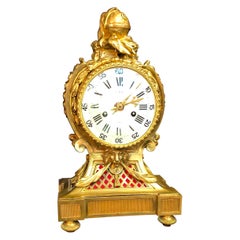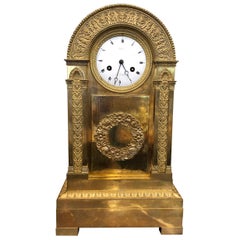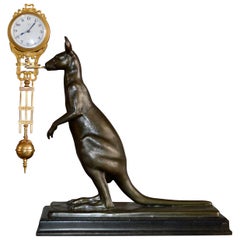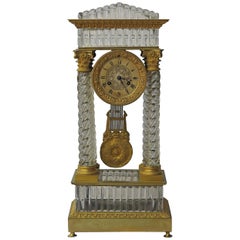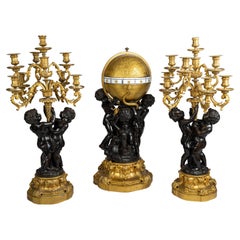Bronze Mantel Clocks
13
1,051
1
to
73
600
366
1,052
1,052
1,052
178
147
66
65
29
27
10
8
8
8
5
3
1
80
880
91
1
66
14
3
15
11
4
1
1
Height
to
Width
to
1,804
1,052
677
631
535
983
915
27
20
15
17
17
11
10
8
Material: Bronze
Large Antique French Rococo Clock by A D Mougin
By A.D. Mougin
Located in Belper, Derbyshire
A large, superb and very decorative original antique French clock dating from circa 1900. It is boldly modelled in the Rococo style in finely gilded bronze. Waisted shaped case, deco...
Category
19th Century French Rococo Antique Bronze Mantel Clocks
Materials
Bronze
Fine French Louis XVI Bronze Mantel Clock by Marquis a Paris
Located in Westwood, NJ
A fine and rare 19th century French Louis XVI bronze Mantel clock by Marquis a Paris. The wonderful clock has elaborate bronze decorations with masks,...
Category
1870s French Louis XVI Antique Bronze Mantel Clocks
Materials
Bronze
18th Century France Louis XVI Gilt Mantel Clock by Lepine, 1790s
By Lepine
Located in Roma, RM
Wonderful golden clock, signed Jean-Antoine Lépine,
(born November 18, 1720, Challex, France, Died May 31, 1814 (aged 93)Paris, France)
a wonderful exam...
Category
1790s French Empire Antique Bronze Mantel Clocks
Materials
Bronze
Art Nouveau Mantelpiece Clock with Kangaroo and Gilded Bronze Spelter
Located in Copenhagen, K
Kangaroo spelter clock by Junghans, with eight-day movement, enamel deal with Arabic numerals, blue-steel hands. The kangaroo stands on a black-stained wooden base.
Category
Early 1900s German Art Nouveau Antique Bronze Mantel Clocks
Materials
Bronze, Spelter
1830' Clock Portico Charles X Crystal Baccarat and Golden Bronze
Located in Paris, FR
Corinthian capitals and golden bronze bases. They support the silvery dial has l allegory of the vineyard Roman numerals, in working order
Category
1820s French Charles X Antique Bronze Mantel Clocks
Materials
Crystal, Bronze
Important Cercles Tournants Rotary Clock set by Deniere
Located in Los Angeles, CA
Very Large Important and Rare Napoleon III Period Ormolu And Patinated Bronze Sculptural rotary 3-piece clock set ("Pendule A Cercles Tournants") compr...
Category
19th Century French Napoleon III Antique Bronze Mantel Clocks
Materials
Bronze
“Cercles Tournants” Louis XVI Mantel Clock, Bronze Attributed to Gouthière
By Pierre Gouthiere
Located in Paris, FR
Important white marble “Cercles Tournants” mantel clock.
Gilt bronze mounts attributed to Pierre Gouthière.
Paris, Louis XVI period, circa 1775...
Category
1770s French Louis XVI Antique Bronze Mantel Clocks
Materials
Marble, Bronze
Sèvres Porcelain Louis XVI Lyre Mantel Clock by Kinable, Dial by Dubuisson
Located in Paris, FR
Dieudonné Kinable
Enamel Dial Attributed to Dubuisson (1731-1815)
Exceptional Porcelain Lyre Mantel Clock from the Royal Sèvres Porcelain Manufactory
Paris, late Louis XVI period, circa 1785-1790
Height 62 cm; width 26 cm; depth 16 cm
The round enamel dial, signed “Kinable”, indicates the hours in Roman numerals, the fifteen-minute intervals in Arabic numerals, the annual calendar and the signs of the Zodiac, by means of four hands, two of which are made of pierced gilt bronze, the two others in blued steel. The magnificent lyre-shaped case is made of “bleu nouveau” Sèvres porcelain and finely chased and gilt bronze. The bezel is made up of a gilt bronze twisted rope; the pendulum is adorned with brilliant-cut paste stones; the body of the lyre is adorned with gilt bronze beading and with laurel leaf and seed motifs, with two rosettes issuing floral and foliate swags. The clock is surmounted by a mask with radiating sunrays. The spreading foot is decorated with beading and twisted rope motifs and a leafy garland. The en-suite decorated oval base is raised upon four flattened ball feet.
The Royal Sèvres Porcelain Factory produced the lyre clock model as of 1785. Four colours were offered: turquoise, green, pink and bleu nouveau. These exceptional clocks were made for the connoisseurs of the time. Louis XVI had a similar clock in his Salon des jeux in Versailles; its dial bore the signature of the clockmaker Courieult (this is almost certainly the example illustrated in P. Verlet, Les bronzes dorés français du XVIIIe siècle, Paris, 1999, p. 41). Kinable, however, was the clockmaker who purchased the greatest number of lyre cases from the factory, and he developed the model in the late 18th century. Among the porcelain lyre clocks signed by this brilliant horologer, one example is in the Victoria & Albert Museum in London (illustrated in H. Ottomeyer and P. Pröschel, Vergoldete Bronzen, Band I, Munich, 1986, p. 252, fig. 4.6.26). A second such clock is in the Royal British Collection (see C. Jagger, Royal Clocks, The British Monarchy & its Timekeepers 1300-1900, 1983, p. 130, fig. 176).
Bibliography:
M. Gay and A. Lemaire, “Les pendules lyre”, in Bulletin de l’Association nationale des Collectionneurs et Amateurs d’Horlogerie ancienne, Winter 1993, n° 68, p. 5-40.
Dieudonné Kinable (active circa 1785-1810)
One of the most important Parisian clockmakers of the late 18th century. His shop was located at n° 131 Palais Royal. He purchased a great number of lyre-type porcelain clock cases...
Category
1780s French Louis XVI Antique Bronze Mantel Clocks
Materials
Bronze
Recently Viewed
View AllMore Ways To Browse
French Clock Round
8 Day Striking Clock
Antique French Clocks Painted
Sevres French Clock
Antique Pedestal Clock
Bronze Garniture Sets
Clock Bronze Putti
French Ormolu White Marble Mantel Clock
French Porcelain Clock Set
Mantel Clock With Vases
Arabic Porcelain
Black And Bronze Mantel Clock
French Winding Clocks
Antique Bracket Clock Case
Chariot Bronze
Sevres Porcelain Clock
18th Century French Mantel Clocks
Clock Garniture Candelabra

